文体学广告advertisement分析
- 格式:pptx
- 大小:275.23 KB
- 文档页数:9
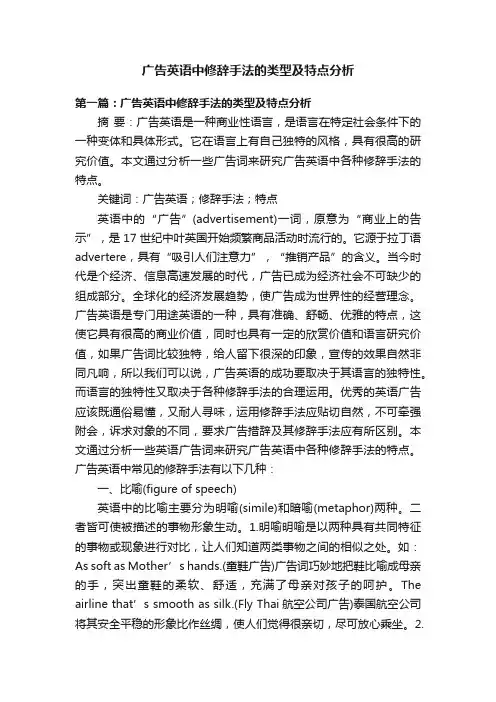
广告英语中修辞手法的类型及特点分析第一篇:广告英语中修辞手法的类型及特点分析摘要:广告英语是一种商业性语言,是语言在特定社会条件下的一种变体和具体形式。
它在语言上有自己独特的风格,具有很高的研究价值。
本文通过分析一些广告词来研究广告英语中各种修辞手法的特点。
关键词:广告英语;修辞手法;特点英语中的“广告”(advertisement)一词,原意为“商业上的告示”,是17世纪中叶英国开始频繁商品活动时流行的。
它源于拉丁语advertere,具有“吸引人们注意力”,“推销产品”的含义。
当今时代是个经济、信息高速发展的时代,广告已成为经济社会不可缺少的组成部分。
全球化的经济发展趋势,使广告成为世界性的经营理念。
广告英语是专门用途英语的一种,具有准确、舒畅、优雅的特点,这使它具有很高的商业价值,同时也具有一定的欣赏价值和语言研究价值,如果广告词比较独特,给人留下很深的印象,宣传的效果自然非同凡响,所以我们可以说,广告英语的成功要取决于其语言的独特性。
而语言的独特性又取决于各种修辞手法的合理运用。
优秀的英语广告应该既通俗易懂,又耐人寻味,运用修辞手法应贴切自然,不可牵强附会,诉求对象的不同,要求广告措辞及其修辞手法应有所区别。
本文通过分析一些英语广告词来研究广告英语中各种修辞手法的特点。
广告英语中常见的修辞手法有以下几种:一、比喻(figure of speech)英语中的比喻主要分为明喻(simile)和暗喻(metaphor)两种。
二者皆可使被描述的事物形象生动。
1.明喻明喻是以两种具有共同特征的事物或现象进行对比,让人们知道两类事物之间的相似之处。
如:As soft as Mother’s hands.(童鞋广告)广告词巧妙地把鞋比喻成母亲的手,突出童鞋的柔软、舒适,充满了母亲对孩子的呵护。
The airline that’s smooth as silk.(Fly Thai航空公司广告)泰国航空公司将其安全平稳的形象比作丝绸,使人们觉得很亲切,尽可放心乘坐。
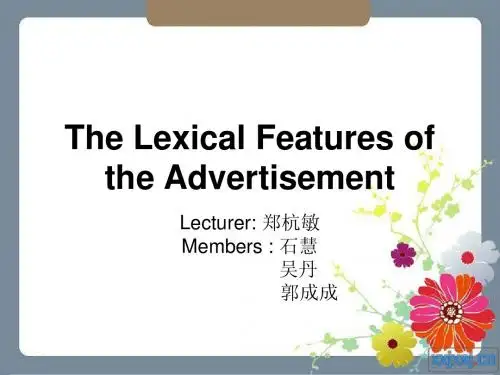
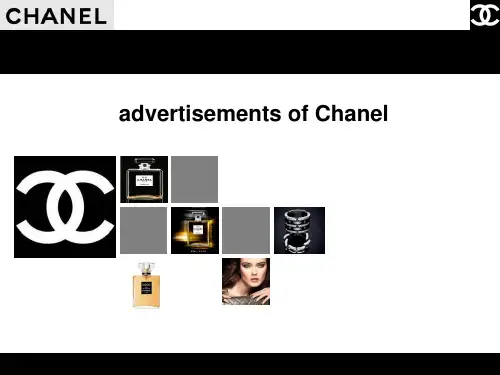
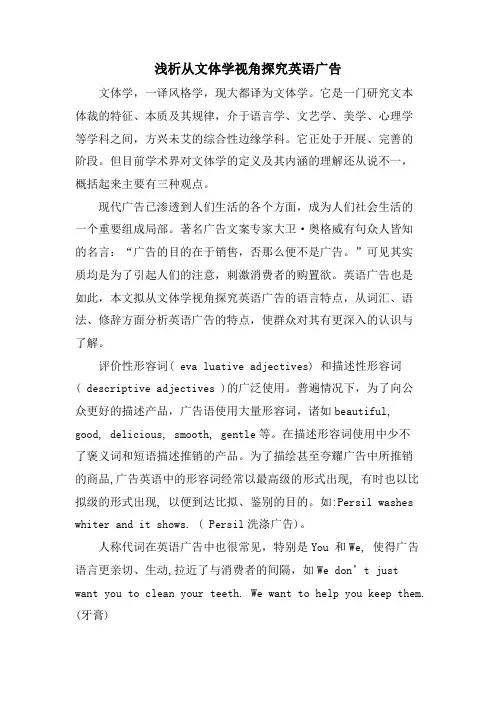
浅析从文体学视角探究英语广告文体学,一译风格学,现大都译为文体学。
它是一门研究文本体裁的特征、本质及其规律,介于语言学、文艺学、美学、心理学等学科之间,方兴未艾的综合性边缘学科。
它正处于开展、完善的阶段。
但目前学术界对文体学的定义及其内涵的理解还从说不一,概括起来主要有三种观点。
现代广告已渗透到人们生活的各个方面,成为人们社会生活的一个重要组成局部。
著名广告文案专家大卫·奥格威有句众人皆知的名言:“广告的目的在于销售,否那么便不是广告。
”可见其实质均是为了引起人们的注意,刺激消费者的购置欲。
英语广告也是如此,本文拟从文体学视角探究英语广告的语言特点,从词汇、语法、修辞方面分析英语广告的特点,使群众对其有更深入的认识与了解。
评价性形容词( eva luative adjectives) 和描述性形容词( descriptive adjectives )的广泛使用。
普遍情况下,为了向公众更好的描述产品,广告语使用大量形容词,诸如beautiful, good, delicious, smooth, gentle等。
在描述形容词使用中少不了褒义词和短语描述推销的产品。
为了描绘甚至夸耀广告中所推销的商品,广告英语中的形容词经常以最高级的形式出现, 有时也以比拟级的形式出现, 以便到达比拟、鉴别的目的。
如:Persil washes whiter and it shows. ( Persil洗涤广告)。
人称代词在英语广告中也很常见,特别是You 和We, 使得广告语言更亲切、生动,拉近了与消费者的间隔,如We don’t just want you to clean your teeth. We want to help you keep them. (牙膏)英语广告中特有的词汇使用是词缀法,许多用“super”作前缀, 用“ex”作后缀构成的词, 具夸张意味,例Windex (擦窗清洁剂名) , Purex (漂泊剂名) 。
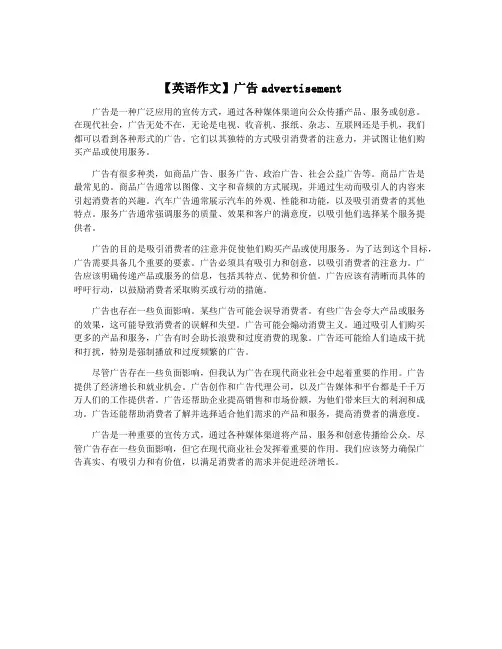
【英语作文】广告advertisement广告是一种广泛应用的宣传方式,通过各种媒体渠道向公众传播产品、服务或创意。
在现代社会,广告无处不在,无论是电视、收音机、报纸、杂志、互联网还是手机,我们都可以看到各种形式的广告。
它们以其独特的方式吸引消费者的注意力,并试图让他们购买产品或使用服务。
广告有很多种类,如商品广告、服务广告、政治广告、社会公益广告等。
商品广告是最常见的。
商品广告通常以图像、文字和音频的方式展现,并通过生动而吸引人的内容来引起消费者的兴趣。
汽车广告通常展示汽车的外观、性能和功能,以及吸引消费者的其他特点。
服务广告通常强调服务的质量、效果和客户的满意度,以吸引他们选择某个服务提供者。
广告的目的是吸引消费者的注意并促使他们购买产品或使用服务。
为了达到这个目标,广告需要具备几个重要的要素。
广告必须具有吸引力和创意,以吸引消费者的注意力。
广告应该明确传递产品或服务的信息,包括其特点、优势和价值。
广告应该有清晰而具体的呼吁行动,以鼓励消费者采取购买或行动的措施。
广告也存在一些负面影响。
某些广告可能会误导消费者。
有些广告会夸大产品或服务的效果,这可能导致消费者的误解和失望。
广告可能会煽动消费主义。
通过吸引人们购买更多的产品和服务,广告有时会助长浪费和过度消费的现象。
广告还可能给人们造成干扰和打扰,特别是强制播放和过度频繁的广告。
尽管广告存在一些负面影响,但我认为广告在现代商业社会中起着重要的作用。
广告提供了经济增长和就业机会。
广告创作和广告代理公司,以及广告媒体和平台都是千千万万人们的工作提供者。
广告还帮助企业提高销售和市场份额,为他们带来巨大的利润和成功。
广告还能帮助消费者了解并选择适合他们需求的产品和服务,提高消费者的满意度。
广告是一种重要的宣传方式,通过各种媒体渠道将产品、服务和创意传播给公众。
尽管广告存在一些负面影响,但它在现代商业社会发挥着重要的作用。
我们应该努力确保广告真实、有吸引力和有价值,以满足消费者的需求并促进经济增长。
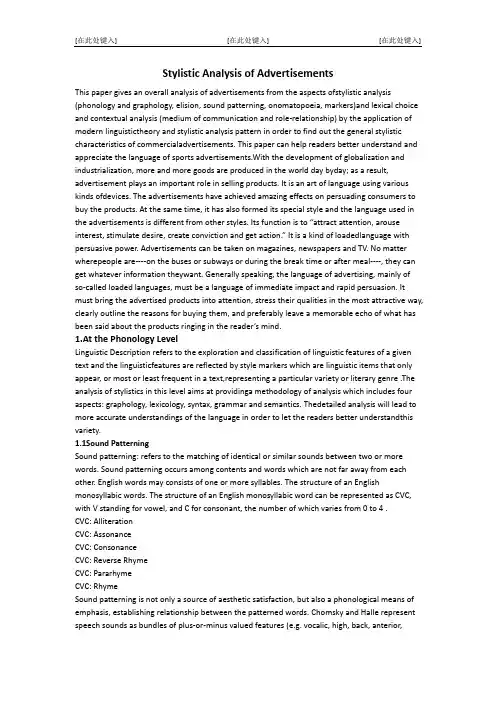
Stylistic Analysis of AdvertisementsThis paper gives an overall analysis of advertisements from the aspects ofstylistic analysis (phonology and graphology, elision, sound patterning, onomatopoeia, markers)and lexical choice and contextual analysis (medium of communication and role-relationship) by the application of modern linguistictheory and stylistic analysis pattern in order to find out the general stylistic characteristics of commercialadvertisements. This paper can help readers better understand and appreciate the language of sports advertisements.With the development of globalization and industrialization, more and more goods are produced in the world day byday; as a result, advertisement plays an important role in selling products. It is an art of language using various kinds ofdevices. The advertisements have achieved amazing effects on persuading consumers to buy the products. At the same time, it has also formed its special style and the language used in the advertisements is different from other styles. Its function is to “attract attention, arouse interest, stimulate desire, create conviction and get action.” It is a kind of loadedlanguage with persuasive power. Advertisements can be taken on magazines, newspapers and TV. No matter wherepeople are----on the buses or subways or during the break time or after meal----, they can get whatever information theywant. Generally speaking, the language of advertising, mainly ofso-called loaded languages, must be a language of immediate impact and rapid persuasion. It must bring the advertised products into attention, stress their qualities in the most attractive way, clearly outline the reasons for buying them, and preferably leave a memorable echo of what has been said about the products ringing in the reader’s mind.1.At the Phonology LevelLinguistic Description refers to the exploration and classification of linguistic features of a given text and the linguisticfeatures are reflected by style markers which are linguistic items that only appear, or most or least frequent in a text,representing a particular variety or literary genre .The analysis of stylistics in this level aims at providinga methodology of analysis which includes four aspects: graphology, lexicology, syntax, grammar and semantics. Thedetailed analysis will lead to more accurate understandings of the language in order to let the readers better understandthis variety.1.1Sound PatterningSound patterning: refers to the matching of identical or similar sounds between two or more words. Sound patterning occurs among contents and words which are not far away from each other. English words may consists of one or more syllables. The structure of an English monosyllabic words. The structure of an English monosyllabic word can be represented as CVC, with V standing for vowel, and C for consonant, the number of which varies from 0 to 4 .CVC: AlliterationCVC: AssonanceCVC: ConsonanceCVC: Reverse RhymeCVC: PararhymeCVC: RhymeSound patterning is not only a source of aesthetic satisfaction, but also a phonological means of emphasis, establishing relationship between the patterned words. Chomsky and Halle represent speech sounds as bundles of plus-or-minus valued features (e.g. vocalic, high, back, anterior,nasal, etc.) The phonological component of each lexical entry is considered to be a linear sequence of these feature bundles. A number of context-sensitive rules transform the underlying form of a sequence of words into the final phonetic form that is uttered by the speaker. These rules are allowed access to the tree structure that the syntax is said to output. This access allows rules that apply, for example, only at the end of a word, or only at the end of a noun phrase. And alliteration is widely accepted in the sports advertisement or brand name as a tool to enhance memory.And it also sound very interesting.So, I’ve compiled a list of examples of alliteration used for commercial purposes.American AirlinesBurberryCoca-ColaFedExPolo (by Ralph Lauren)Ted TalksA TailOf Two CitiesDriven To DistractionGood to Great[The] Great GatsbyPride And PrejudiceAlibabaCitySearchGoogleTwitterYouTubeWish You Were HereBaby BoomersBB Gun1.2OnomatopoeiaSome words as bang, hiss, sizzle, moo, are said to be onomatopoeia, or echoic,i.e.,their sounds are imitative of their senses; but the relationship between the sound and sense of a word is weakly iconic, some linguists have rightly pointed out that “onomatopoeia”is actually the mutual reinforcement of sense by sound and sound by sense.2.At the Lexical LevelLinguistic Description refers to the exploration and classification of linguistic features of a given text and the linguisticfeatures are reflected by style markers which are linguistic items that only appear, or most or least frequent in a text,representing a particular variety or literary genre The analysis of stylistics in this level aims at providinga methodology of analysis which includes four aspects: graphology, lexicology, syntax, grammar and semantics. Thedetailed analysis will lead to more accurate understandings of the language in order to letAdvertising language is marked by a wealth of adjective vocabulary, and a poverty of verb vocabulary.” Among the highly frequent key words are:delicious,latest,up-to-date,fragrant, charming, attractive, long-lasting, unique, perfect,etc. In order to stress the uniqueness or novelty of a product advertisers resort toneologism, and improvised adjectival sructures.2.1Using a lot of general and vague wordsIn ordinary daily exchange , clichés and general or vague words are often used when there is no need for saying anything original, or when the speaker doesn’t know how to express exactly what he wants to say, or when he simply wants to maintain the informal atmosphere of a conversation. Common vague or general words are: t hing , stuff, things like that , got , do, nice , thingummy, what-do- you –call-it, what’s-her-name, etc. The vague nouns are substitutes for names not recalled, that is , they are used instead of nouns that one cannot remember.A word is GENERAL when it refers to a group or objects or a class of objects or action. General terms are preferred, when there is no need for specification, or when the user wants to leave things vague for some reason.Such as the BMW advertisement on 2010 London Olympics;SOMETIMES PERFORMANCE WINSSOMETIMES BALANCESOMETIMES AGILITY WINSSOMETIMES CONTROLWHAT ALL WINNERS HAVE IN COMMON iSJOY.On this advertisement,SOMETIMES is a vague, this word can refer to the athletes both the cars have those excellent performance. Using this vague word, can 突出产品的优点。
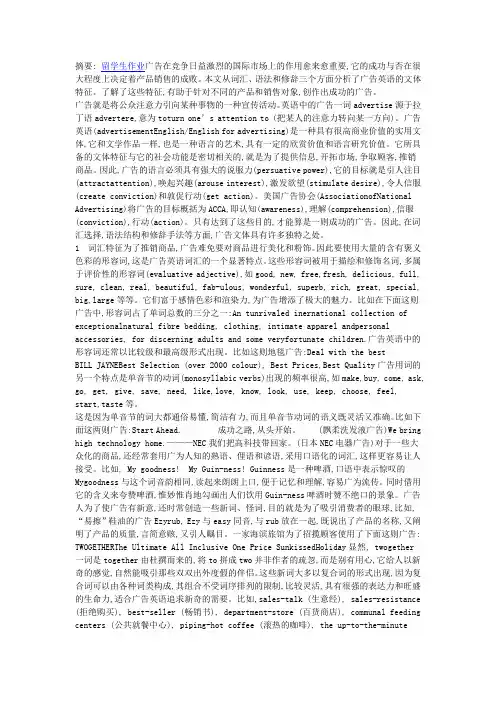
摘要: 留学生作业广告在竞争日益激烈的国际市场上的作用愈来愈重要,它的成功与否在很大程度上决定着产品销售的成败。
本文从词汇、语法和修辞三个方面分析了广告英语的文体特征。
了解了这些特征,有助于针对不同的产品和销售对象,创作出成功的广告。
广告就是将公众注意力引向某种事物的一种宣传活动。
英语中的广告一词advertise源于拉丁语advertere,意为toturn one’s attention to (把某人的注意力转向某一方向)。
广告英语(advertisementEnglish/English for advertising)是一种具有很高商业价值的实用文体,它和文学作品一样,也是一种语言的艺术,具有一定的欣赏价值和语言研究价值。
它所具备的文体特征与它的社会功能是密切相关的,就是为了提供信息,开拓市场,争取顾客,推销商品。
因此,广告的语言必须具有强大的说服力(persuative power),它的目标就是引人注目(attractattention),唤起兴趣(arouse interest),激发欲望(stimulate desire),令人信服(create conviction)和敦促行动(get action)。
美国广告协会(AssociationofNational Advertising)将广告的目标概括为ACCA,即认知(awareness),理解(comprehension),信服(conviction),行动(action)。
只有达到了这些目的,才能算是一则成功的广告。
因此,在词汇选择,语法结构和修辞手法等方面,广告文体具有许多独特之处。
1 词汇特征为了推销商品,广告难免要对商品进行美化和粉饰。
因此要使用大量的含有褒义色彩的形容词,这是广告英语词汇的一个显著特点。
这些形容词被用于描绘和修饰名词,多属于评价性的形容词(evaluative adjective),如good, new, free,fresh, delicious, full, sure, clean, real, beautiful, fab-ulous, wonderful, superb, rich, great, special, big,large等等。
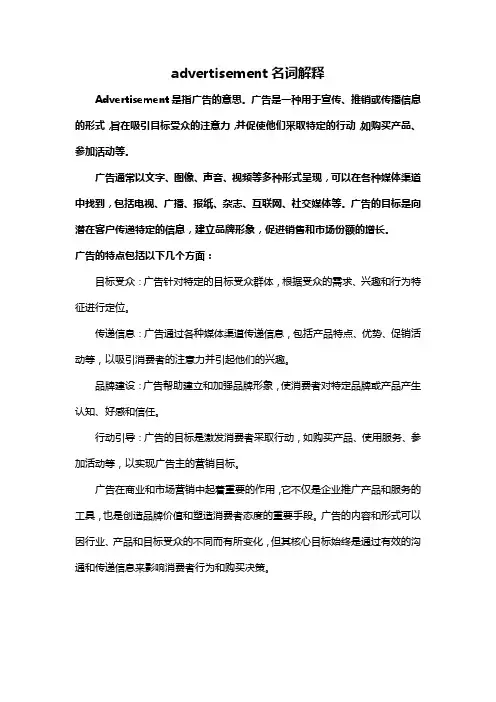
advertisement名词解释
Advertisement是指广告的意思。
广告是一种用于宣传、推销或传播信息的形式,旨在吸引目标受众的注意力,并促使他们采取特定的行动,如购买产品、参加活动等。
广告通常以文字、图像、声音、视频等多种形式呈现,可以在各种媒体渠道中找到,包括电视、广播、报纸、杂志、互联网、社交媒体等。
广告的目标是向潜在客户传递特定的信息,建立品牌形象,促进销售和市场份额的增长。
广告的特点包括以下几个方面:
目标受众:广告针对特定的目标受众群体,根据受众的需求、兴趣和行为特征进行定位。
传递信息:广告通过各种媒体渠道传递信息,包括产品特点、优势、促销活动等,以吸引消费者的注意力并引起他们的兴趣。
品牌建设:广告帮助建立和加强品牌形象,使消费者对特定品牌或产品产生认知、好感和信任。
行动引导:广告的目标是激发消费者采取行动,如购买产品、使用服务、参加活动等,以实现广告主的营销目标。
广告在商业和市场营销中起着重要的作用,它不仅是企业推广产品和服务的工具,也是创造品牌价值和塑造消费者态度的重要手段。
广告的内容和形式可以因行业、产品和目标受众的不同而有所变化,但其核心目标始终是通过有效的沟通和传递信息来影响消费者行为和购买决策。

学 术 论 坛242科技资讯 SC I EN C E & TE C HN O LO G Y I NF O R MA T IO N 广告标语是每一则广告中最引人注目的部分,是广告策划者为达到一定目的而提出的有鼓动作用的简洁明确的语句。
它不仅是一种商业促销手段,更是一种文化现象。
我们在许多优秀的广告中都能发现语言在其中所起的重要作用。
在特定的文化语境和情景语境下,不同的广告标语会有其各自的特色和文化含蕴。
广告标语在特定的文化语境中能起到特有的交际作用,而从语言的使用角度看,其情景语境包括语场、基调和方式。
广告标语中,语场指广告这一社会活动的特点及其语言所谈及或描述的内容;基调指广告标语撰写者的行为特点和所处社会地位、角色等;方式指广告标语在广告这一交际活动中所起的渠道作用。
语场体现了广告标语的概念功能;基调体现了广告标语的人际功能;而方式则体现了广告标语的语篇功能。
下面从广告标语的语言表现手法谈谈标语的语言艺术,浅析广告语篇如何在特定的文化语境和情景语境中达到预想的效果。
1 广告标语的语言表现手法标语要追求理想的表达效果就必须运用恰当的语言手段。
运用恰当的语言表现手法可以使广告标语更深入人心,从而达到推销产品的目的,激发消费者的购买欲望。
下面从语音、语词、语句三个方面谈谈标语中语言表现手法的运用。
1.1声音的巧妙配合汉语是一种富有音乐性的语言,如果运用得当,往往能达到超乎寻常的效果。
好的广告标语善于运用音韵的一致或是协调来增强其声音美,让人印象深刻,留下持久的记忆。
例如,“要想胃舒,请服胃苏”(胃药广告)。
巧妙的押韵使标语读起来朗朗上口,悦耳动听,便于记忆。
再例如,“一旦拥有,别无所求”(手表广告)。
音节对应,结构整齐,形式美观,同样让人不易忘记。
1.2词语的巧妙运用广告标语是由词语组成的,词语运用得是不是准确贴切,直接影响到广告的表达效果。
广告标语中词语的巧用之处有很多,下面仅举出以下两种:1.2.1词语的仿用。
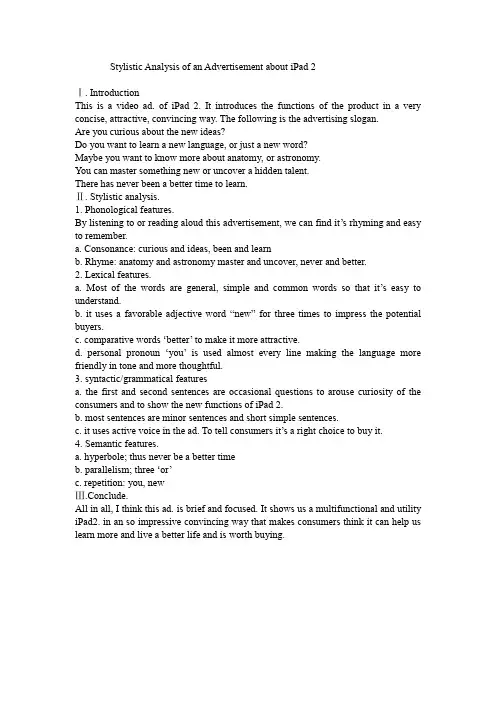
Stylistic Analysis of anAdvertisement about iPad 2Ⅰ.IntroductionThis is a video ad. of iPad 2. It introduces the functions of the product in a very concise, attractive, convincing way. The following is the advertising slogan.Are you curious about the new ideas?Do you want to learn a new language, or just a new word?Maybe you want to know more about anatomy,or astronomy.You can master something new or uncover a hidden talent.There hasnever been a better time to learn.Ⅱ.Stylistic analysis.1. Phonological features.By listening to or reading aloud this advertisement, we can find it‟s rhyming and easy to remember.a. Consonance: curious and ideas, been and learnb. Rhyme: anatomy and astronomy master and uncover, never and better.2. Lexical features.a. Most of the words are general, simple and common words so that it‟s easy to understand.b. it uses a favorable adjective word “new” for three times to impress the potential buyers.c. comparative words…better‟ to make it more attractive.d. personal pronoun …you‟is used almost every line making the language more friendly in tone and more thoughtful.3. syntactic/grammatical featuresa. the first and second sentences are occasional questions to arouse curiosity of the consumers and to show the new functions of iPad 2.b. most sentences are minor sentences and short simple sentences.c. it uses active voice in the ad. To tell consumers it‟s a right choice to buy it.4. Semantic features.a. hyperbole; thus never be a better timeb.parallelism; three …or‟c. repetition: you, newⅢ.Conclude.All in all, I think this ad. isbrief and focused. It shows us a multifunctional and utility iPad2.in an soimpressiveconvincingwaythat makes consumersthink it can help us learn more and live a better life and is worth buying.。
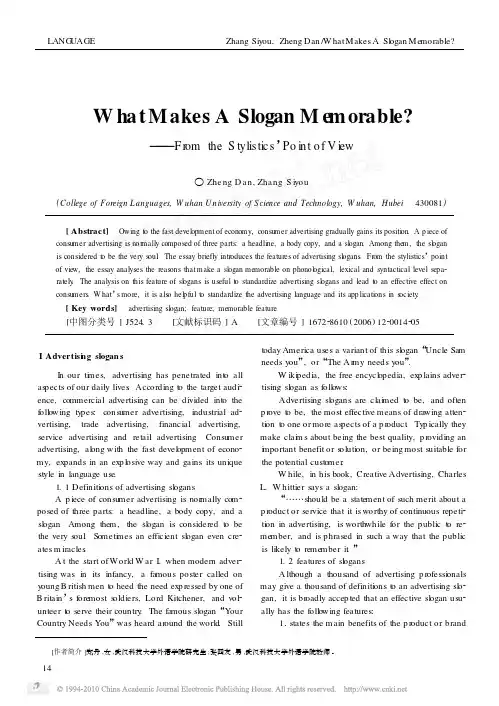
[作者简介]郑丹,女,武汉科技大学外语学院研究生;张四友,男,武汉科技大学外语学院教师。
W hatMakes A Slogan M e morable?———F r om the S tylis ti c s ’Po i n t o f V i ew○Zhe ng D an,Zhang S iyo u(College of Foreign L anguages,W uhan U niversity of Science and Technology,W uhan,Hubei 430081) [Abstract] Owing t o the fast devel opment of economy,consu mer advertising gradually gains its positi on .A p iece ofconsu mer advertising is nor mally composed of three parts:a headline,a body copy,and a sl ogan .Among the m,the sl ogan is considered t o be the very s oul .The essay briefly intr oduces the features of advertising sl ogans .Fr om the stylistics ’point of vie w,the essay analyses the reas ons that make a sl ogan me morable on phonol ogical,lexical and syntactical level sepa 2rately .The analysis on this feature of sl ogans is useful t o standardize advertising sl ogans and lead t o an effective effect on consu mers .W hat ’s more,it is als o hel pful t o standardize the advertising language and its app licati ons in s ociety . [Key words] advertising sl ogan;feature;me morable feature [中图分类号]J524.3 [文献标识码]A [文章编号]167228610(2006)1220014205I .Advertisi n g slogan sI n our ti m es,advertising has penetrated int o all as pects of our daily lives .According t o the target audi 2ence,commercial advertising can be divided int o the foll owing ty pes:consu mer advertising,industrial ad 2vertising,trade advertising,financial advertising,service advertising and retail advertising .Consu mer advertising,al ong with the fast devel opment of econo 2my,expands in an exp l osive way and gains its unique style in language use .1.1Definiti ons of advertising sl ogans A p iece of consu mer advertising is nor mally com 2posed of three parts:a headline,a body copy,and a sl ogan .Among the m ,the sl ogan is considered t o be the very s oul .So meti m es an efficient sl ogan even cre 2ates m iracles .A t the start ofWorld W ar I,when modern adver 2tising was in its infancy,a fa mous poster called on youngB ritish men t o heed the need exp ressed by one of B ritain ’s f ore most s oldiers,Lord Kitchener,and vol 2unteer t o serve their country .The fa mous sl ogan “Your Country Needs You ”was heard ar ound the world .Stillt oday America uses a variant of this sl ogan “Uncle Sa mneeds you ”,or “The A r my needs you ”.W iki pedia,the free encycl opedia,exp lains adver 2tising sl ogan as f oll ows:Advertising sl ogans are clai m ed t o be,and often p r ove t o be,the most effective means of dra wing atten 2ti on t o one or more as pects of a p r oduct .Typ ically they make clai m s about being the best quality,p r oviding an i m portant benefit or s oluti on,or being most suitable for the potential cust o mer .W hile,in his book,Creative Advertising,Charles L.W hittier says a sl ogan:“……should be a statement of such merit about a p r oduct or service that it is worthy of continuous repeti 2ti on in advertising,is worthwhile for the public t o re 2me mber,and is phrased in such a way that the public is likely t o re me mber it .”1.2features of sl ogansA lthough a thousand of advertising p r ofessi onals may give a thousand of definiti ons t o an advertising sl o 2gan,it is br oadly accep ted that an effective sl ogan usu 2ally has the foll owing features:11states the main benefits of the p r oduct or brand41for the potential user or buyer21i m p lies a distincti on bet w een it and other fir m s’p r oducts31makes a si m p le,direct,concise,cris p,and ap t state ment41is often witty,51adop ts a distinct“pers onality”of its own61gives a credible i m p ressi on of a brand or p r od2 uct71makes the consumer feel“good”81makes the consumer feel a desire or need91is hard t o forget-it adheres t o one’s me moryFr om all these features,one can extract the es2 sence of sl ogans:a means of eli m inati on in trade com2 petiti ons.T o efficiently attain this goal,a sl ogan should firstly be me morable.I n case that a sl ogan were not me morized by consu mers,all other features are of no avail.Then,what makes a sl ogan me morable?II.W ha t makes a slogan m e m orable?2.1On the phonol ogical level2.1.1Theoretical bases:the si m ilarity of p r os ody aids me moryA r obust finding in working me mory research is that t o recall a set of phonol ogically si m ilar words is much more difficult than t o recall a set of phonol ogical2 ly dissi m ilar words.It is the well2known phonol ogical2 si m ilarity effect.(Conrad&Hull,1964)However, based on his own experi m ents,M icheal C.W.Yi p ar2 rives at a conclusi on that the p r os odic infor mati on of the t o2be2me morized materials see m s t o be retained l onger in the working me mory.That is t o say,si m ilari2 ty in p r os odic inf or mati on will not create any interfer2 ence effect,but a facilitat ory effect in working me mory instead.For exa mp le,most of the Chinese peop le have the subjective experience that t o i m mediately recall a set of coll oquial sl ogans in televisi on advertise ment is much easier than t o i m mediately recall a set of common sentences due t o the si m ilarity of p r os ody.The instance p r oves that the si m ilarity of p r os ody perf or m a positive functi on in me morizing p r ocess.Since p r os ody is the study of the rhyth m,pause,te mpo,stress and p itch features of a language,we may conclude that a sen2 tence of regular patterns tends t o be more easily me mo2 rized than a common sentence.I n this paper,regular patterns of sentences are inter p reted not only on the syntactical level but als o on the level of s ounds.Gener2 ally s peaking,regular patterns of sentences are mostlymaterialized by rhet orical devices.Therefore,based on all these analyses,we may come t o a reas onable con2 clusi on that the app licati on of vari ous rhet orical devices shall aid me mory.2.1.2A lliterati onA lliterati on is defined as“the recurrence of the sa me initial s ound in words in cl ose successi on”.The use of alliterati on makes a sentence s ound har moni ous. It als o makes a sentence easy t o read and me morize. Someti m es it works t o create a funny as well as witty sl ogan.W e’ll bring for ward numer ous cases t o illus2 trate it.B ritain’s best business bank.(A llied Irish Bank)D iscover the Doral difference.(Doral)Don’t drea m it.D rive it.(Jaguar)D rea m.Dare.Do.(Girl Guides)Functi onal…Fashi onable…For m idable…(Fila)Specialized staffing s oluti ons.(H ire Knowledge)Your flexible friend.(Access)Transf or m ing bathr oom s beautifully.(Dol phin)Honey well home s oluti on a wait you.(Honey well)Don’t rep lace,rest ore.(The Sash W indow Workshop)An efficient app licati on of alliterati on gives an in2 delible i m p ressi on on consu mers.W e’ll cite an exa m2 p le t o illustrate the case.The sl ogan“B ritain’s best business bank”is considered t o be a typ ical case.A ll the four words used in the sl ogan possess the sa me ini2 tial s ound.Moreover,all the four initial s ounds are stressed.I n this way,the p r ofessi onal writer creates a musical rhythm,by which consumers are very i m2 p ressed and shall bear the witty sl ogan in me mory natu2 rally.2.1.3Rhy meRhy me is nor mally used in writing poe m s.Togeth2 er with meter and f oots,rhy me is generally e mp l oyed in poe m s t o f or m a certain rhythm and har mony,as the foll o wing exa mp le shows:R ich the treasure,S weet the p leasure;(John D ryden)However,rhy me used in a single sentence still works t o f or m har mony.I n this sl ogan“It’s the V iakal fizz that does the bizz!”,the t w o words“fizz”and “bizz”obvi ously f or m a perfect rhy me:The stressed vowels are the sa me,the s ounds before the vowel are different,and the s ounds after the vowel are the sa me. W hat’s more,the sl ogan uses the tr ochaic foot.The51rhy me and the f oot e mp l oyed enable the sl ogan t o have a p leasing rhyth m,and make it a p leasure t o read it.A Mars a day hel p s you work,rest and p lay. (Mars)It’s the V iakal fizz that does the bizz!(1992) (V iakal)It’s the Andre ws fizz that does the bizz.(1996) (Andre ws Antacid)M ilk’s gotta l otta bottle.(M ilk)Soothe it a way the O raldene way.(O ralden)Savour the flav our of Belgiu m.(Flanders,Bel2 gium)Nevertheless,these sl ogans listed above have a common weak point.Thr ough attentive observati on, one may find out that the brand na me is menti oned but it does not actually rhy me.The f oll owing sl ogans may be more efficiently written.City L inking,s mart thinking.(City L ink)Don’t be vague.A sk f or Haig.(Haig Scotch)T o save and invest,talk t o Nat w est.(Nat w est Bank)It needn’t be hell with N icotinell.(N icotinell)The flavour of a Quaver is never known t o waver. (Quavers)Stay contented,get Radi o Rented.(Radi o Rent2 als)Don’t get vexed.A sk Teletext.(Teletext)Don’t just book it,Thomas Cook it.(Thomas Cook)2.2On the lexical level2.2.1Theoretical base:deliberate a mbiguity aids me moryI n sl ogans,a mbiguity is often e mp l oyed t o p ique the interest of the consumers.According t o several the2 ories of text p r ocessing,this deliberate a mbiguity may gain greater app reciati on than sl ogans e mp l oying other rhet orical means.A s pecial f or m of deliberate a mbigui2 ty is al w ays e mp l oyed t o write sl ogans.This s ort of sl o2 gans may be taken literally.The noti on of salient meaning exp lains what happens when idi omatic mean2 ing is reinter p reted int o literal meaning,t o fit the con2 text.It i m p lies that a sl ogan e mp l oying deliberate a m2 biguity nor mally have t w o meanings:literal meaning and idi omatic meaning.L iteral meaning exp lains what happens,while idi omatic meaning can only be ex2 p lained in context.This kind of a mbiguity evokes hu2 mor.An experi m ent shows that deliberate a mbiguity in sl ogans has a positive effect on app reciati on.Recogni2ti on of the a mbiguity is a str ong fact or in the app recia2 ti on of these sl ogans.2.2.2PunPun,one of rhet orical devices,is the deliberate a mbiguity in actual use.Pun refers t o the humor ous use of a word or a combinati on of words s o as t o e m2 phasize different meanings or app licati ons.Let’s illus2 trate the case with a si m p le exa mp le.“GetMore Satisfacti on.”(More)More is the na me of a cigarette company.The brand name of the company is:“More”,which has the sa me f or m and p r onunciati on with“more”,the relative for m of“many”.The p r ofessi onal writer made full use of this fact and created such a witty sl ogan.I n the sl o2 gan,the word“More”can either be comp rehended as a synony m of“extra”or just the brand name itself.I n this case,the use of deliberate a mbiguity achieved great success.The sl ogan not only i m p resses the con2 su mers with the unique character of the p r oduct,but als o gives the consu mers a credible i m p ressi on of the brand“More”.More exa mp les are given:A l w ays p ick Fl owers.(Fl owers Fine A les)Barbados.Goodness.Graci ous.(Barbado)B rilliant cleaning starts with Finish.(Finish De2 tergent)B ritish mettle.(B ritish Steel)First relati onshi p s last.(First Nati onal Bank of Chicago)Get R ich quick.(Kenco Really R ich Coffee)Get your fa m ily int o Shape,without the m even no2 ticing.(St.I vel Shape Yogurt)Is y our fil m as good as Gold?(Kodak Gold)It’asda be A sda.(A sda)No H MV,no video.(H MV)Nothing fitz like a R itz.(R itz Crackers)Nothing runs like a Deere(John Deere Tract ors)One word cap tures the moment.Mumm’s the word.(Mu mm’s Cha mpagne)Reap the re wards of Money.(Money Magazine)Send y our parcels Red Star and pull out all the st op s.(Red Star)Tetley make teabags make tea.(Tetley Tea)Surely the best tactic.(Tic Tac Candy)You just can’t hel p acting on I m pulse.(I m pulse Deodorant)I n above lines,the brand na me appears,but as the s oluti on or p r om ise rather than as part of the pun. The most skillfully written sl ogans are as f oll ows.The61brand goes t o work,inextricably part of the pun.Abs olut magic.(Abs olut Vodka)Because the Citi never sleep s.(Citibank)Chexellent,or what?(Fr osted Chex)Do me a Quaver.(Quavers Snacks)Don’t just book it,Thomas Cook it.(Thomas Cook)Good mornings f oll ow a good Nyt ol.(Nyt ol Sleep2 ing Pills)I think,theref ore I B M.(I B M)I nvest m ents with Abbey endings.(Abbey Nati on2 al Building Society)L ive a Cutty above.(Cutty Sark W hisky)Lowering p rices forever,that’s Comet sense. (Comet Electrical St ores)Nothing else is A rthur’s good.(A rthur’s Cat Food)Put your money on the Fav orit.(Skoda Favorit)So Farley’s,s o good.(Farley’s Baby Food)Take a Tho mas Cook at our p rices!(Thomas Cook Travel)The l ook is I m mac2ulate(I m mac Dep ilat ory)V isa’s Delta bl ow t o cheques(V isa Delta Debit Card)You can’t keep quiet about a W is pa(Cadbury’s W is pa Candy)You’ll find there is no Ca mparis on.(Ca mpari Aperitif)You’llW ike it t oo.(W ike Far m s Cheese)2.2.3Nonce wordsT o attract consu mers’attenti on,nonce words are coined with intenti on.On most part this strategy ob2 tains an excellent effect on the consu mers by evoking the consu mers’curi osity.The nonce words are ne wly2 created words.Thus,consu mers have t o guess the meaning of these words.I n most cases,these words can only be exp lained in a given context.Theref ore, while the consu mers guessing their meaning;they have t o take account of the nature of the company.I n this way,p r ofessi onal writers successfully call consu mers’attenti on both t o the sl ogan itself and t o the na me of the company.Chineasy.(Amoy)Ep ileather.(Louis Vuitt on)Every wear.(Burt on Mens wear)Fruitius.Yogurtus.Delicia.(Ski Fruit)Guinnless isn’t good f or you.(Guinness)I nnervigorati on.(Gordon’s&T onic)Nefficiency.(Neff)Pure snacking.Pure snacktivity.(KP Peanuts)Wotal otI got!(S marties)2.3On the syntactical levelOn the level of sentence,s orts of rhet orical de2 vices are used in order t o exercise positive influence on the consumers.Hyperbole,parallelis m and pers onifi2 cati on are all frequently used ones.2.3.1HyperboleSl ogans are created t o sell p r oducts.It is required t o state the main benefits of the p r oduct f or the poten2 tial user or buyer and t o make the consu mers feel a de2 sire or need.T o achieve this goal,hyperboles are often used t o insinuate excellent quality of a p r oduct or the efficiency of a company.Let’s have a l ook at s ome ex2 a mp les:It’s every where you want t o be.(V isa)The world’s favorite airline.(B ritish A ir way)Start the day with great taste.(Nescafe)The na me that covers the earth.(Loyd’s of Lon2 don)The world’s reference point of ne ws.(BBC Ne ws24)A p reparati on for life.(Hurst p ier point College)Pr obably the best beer in the world.(Carlsberg)A ll the ne ws that’s fit t o p rint.(The Ne w York Ti m es)Give us20m inutes and we’ll give you the world. (W I N S Radi o,Ne w York)I n this kind of sl ogans,big words such as“world, great,life,best,all”are used t o insinuate that the p r oducts recommended are of good quality and are used all over the world.These hints bet w een lines can al2 ways be easily caught by consumers and affect the con2 su mers’decisi ons in wardly.L it otes is another way of ext olling the excellent quality of p r oducts.It is a f or m of understate ment, which means negative for m s are used t o exp ress an af2 fir mative.Thus,it is a more intelligent way t o put the idea acr oss t o the consu mers.Nothing runs like a Deere.(John Deere)Someone isn’t using Amp lex.(Amp lex Deodor2 ant)Don’t leave home without it.(American Ex2 p ress)Betcha can’t eat just one.(Lay’s)2.3.2Parallelis mParallelis m is e mp l oyed t o construct regular pat271terns of sentences.The well2balanced structure of the sentence makes the sl ogan unf orgettable.“No FT,no comment”comes fr o m Financial Ti m es.The brief and parallel pattern of the line for m s an affir mative t one as an i m perative sentence.Everyone can feel its power and certainty.The parallel structure,t o s ome extent, hel p s t o create the powerful influence on the consu m2 ers.O ther exa mp les are given:W hen you got it,flaunt it.(B raniff A irline)No FT,no co mment.(Financial Ti m es)Someti m es you feel like a nut,s ometi m es you don’t.(Peter PaulMounds)I f it’s on,it’s in.(Radi o Ti m es)Know H MV,know music.(H MV)Don’t just set the table,set the scene.(Denby Pottery)2.3.3Pers onificati on and transferred ep ithetPers onificati on and transferred ep ithet are used t o attract attenti on.Special effects are created by using unexpected modifiers and adhering hu man feelings t o inani m ate p r oducts.Honey well home s oluti ons a wait you.(Honey2 well)The Citi never sleep s.(Citibank)Push thr ough the pain.(Tylenol)Danger ous entertaining.(V irgin Megast ores)Fly the friendly skies.(United A irlines)The world’s favorite airline.(B ritish A ir ways) III.Conclusi onFr om the stylistics’point of view,the essay ana2 lyses the reas ons that make a sl ogan me morable on phonol ogical,lexical and syntactical level separately. The analysis on this feature of sl ogans is useful t o standardize advertising sl ogans and lead t o a effective effect on consu mers.W hat’s more,it is als o hel pful t o standardize the advertising language and its app lica2 ti ons in s ociety.【References】[1]卢炳群.英汉辞格比较与唐诗英译散论[M].青岛:青岛出版社,2003.[2] 王佐良,丁往道.英语文体学引论[M].北京:外语教学与研究出版社,1987.[3] 秦秀白.英语语体和文体要略[M].上海:上海外语教育出版社,2001.[4] Lager werf,D eliberate Am biguity In S logans:Recognitionand A ppreciation.Jone Benja m ins Publishing Company,2002.[5] M ichael C.W.Yi p,W hat is si m ilar in Phonological2si m2ilar Effect?Myi p@.hk.[6] Ti m othy R.V.Foster,The A rt and Science of the Adver2tising Sl ogan www.adsl /.从文体学的角度分析广告标语的易记特征郑丹,张四友(武汉科技大学外语学院,湖北 武汉 430081)[摘 要] 随着经济的快速发展,当今社会广告越来越深入人们生活的各个方面。
Abstract: Advertising is a form of communication intended to persuade an audience (viewers, readers or listeners) to purchase or take some action upon products, ideals, or services. And as a practical language, advertising English has its specific functions. In order to achieve its aim, its way of choosing words and building sentences are quite different from normal English: English advertisements are usually very short, clear, distinctive and memorable. This paper aims to discuss the features of advertising English from the stylistic and rhetorical perspective.1 The Stylistic Features of English Advertisements1.1 Use of Simple, Short and Every Day SentencesIn order to reduce the cost, the advertiser usually use the smallest space and the minimum time, which makes sentences in most advertisements are very short and snappy, especially the headlines, which may or may not be accompanied by a longer informative text. The sentence consists of subject verb and object that are accompanied by an explanatory supplement.The headline is normally expanded or clarified in the text body, where simple,elliptical and compound sentences or their fragments are used. Here are some examples.a. Things go better with Coca—Cola.(饮可口可乐,万事如意。
从辞汇、语法和修辞三个方面分析广告英语的文体特点摘要:广告在竞争日趋猛烈的国际市场上的作用愈来愈重要,它的成功与否在专门大程度上决定着产品销售的成败。
本文从辞汇、语法和修辞三个方面分析了广告英语的文体特点。
了解了这些特点,有助于针对不同的产品和销售对象,创作出成功的广告。
广告确实是将公众注意力引向某种事物的一种宣传活动。
英语中的广告一词advertise源于拉丁语advertere,意为toturn one’s attention to (把某人的注意力转向某一方向)。
广告英语(advertisementEnglish/English for advertising)是一种具有很高商业价值的有效文体,它和文学作品一样,也是一种语言的艺术,具有必然的欣赏价值和语言研究价值。
它所具有的文体特点与它的社会功能是紧密相关的,确实是为了提供信息,开拓市场,争取顾客,推销商品。
因此,广告的语言必需具有壮大的说服力(persuative power),它的目标确实是引人注目(attractattention),唤起爱好(arouse interest),激发欲望(stimulate desire),令人信服(create conviction)和敦促行动(get action)。
美国广告协会(AssociationofNational Advertising)将广告的目标归纳为ACCA,即认知(awareness),明白得(comprehension),信服(conviction),行动(action)。
只有达到了这些目的,才能算是一那么成功的广告。
因此,在辞汇选择,语法结构和修辞手法等方面,广告文体具有许多独特的地方。
1 辞汇特点为了推销商品,广告不免要对商品进行美化和粉饰。
因此要利用大量的含有褒义色彩的形容词,这是广告英语辞汇的一个显著特点。
这些形容词被用于刻画和修饰名词,多属于评判性的形容词(evaluative adjective),如good, new, free,fresh, delicious, full, sure, clean, real, beautiful, fab-ulous, wonderful, superb, rich, great, special, big,large等等。
浅析文学文体学在英语广告当中的应用" 论文关键词:广告用语商品标语文学文体学论文摘要:本文深入研究了文学文体学,即修辞格与诗歌韵律的手法在英语广告中的运用。
广告用语包罗万象、丰富多彩,但都有一个主要功能,即劝说功能。
广告成了厂家进军市场的首要武器,广告语的使用也显得尤为重要。
本文首先从广告的基本组成部分,即品牌名称和商品标语谈起,然后着重介绍了广告用语中应用的文学文体学手法,即修辞格和诗歌韵律。
对品牌名及商品广告标语的语言特点,本文都引用了大量的广告实例加以证明,以求达到具体、真实的效果。
我们无法想象生活中没有了广告会是什么样子。
通过广告,我们可以了解各种商品的相关信息。
如果我们用眼睛和心灵去感受,则会发现广告带给我们了一个缤纷多彩的世界。
文学文体学特指阐述文学文体的主题意义和美学价值为目的的文学学派,注重探讨作者如何通过语言的选择来表达和加强其内在含义。
修辞格和诗歌韵律是它的两个主要分支。
本文重点阐述了文学文体学的各种不同形式在英语广告中的运用。
1 英语广告的基本组成部分1.1 商标(Brand Names)商标是一个品牌最显著的标志,其发展历史悠久并且有很多不同的表现形式。
以下具体地加以说明。
(1)普通词汇(Common Words)。
很多公司使用普通词汇作为自己的商标用语。
这些词汇能够建立起商品良好的形象并给消费者留下深刻的印象。
Sharp[夏普](空调)。
It makes you sharply cold.Safeguard[舒服佳](香皂)。
Safeguard you body.(2)新造词汇(Created Words)。
为了使自己的品牌与众不同,商家创造出很多原本不存在的词语。
例如:Kleenex[clean+excellent 舒洁](纸巾)。
Rolex[rolling+excellent劳力士](手表)。
(3)外来词汇(Loan Words)。
外来词汇给人一种异国氛围,增加了美和新奇感,比如Evian[依云](矿泉水)。
英语商业广告的文体分析程艳【摘要】Advertisement English is a highly practical style of much commercial value,and an important kind of commercial advertise- ment falls into this category. Undoubtedly,the commercial advertisements are playing a more and more important role in people's every- day life. This article tends to make a stylistic analysis of commercial advertisements from perspectives of lexicology, syntax and rhetoric devices. More specifically, the author will investigate some particular features with regard to the use of words, the word-formation, the ad- dressing forms; the sentence type,the time and tense; some prominent figures of speech such as repetition and parallelism, alliteration and rhyme,etc. These features make the English commercial advertisements have both the informative value and empathefie effect.%广告文体是一种具有很高商业价值的实用文体,其中包括重要的一类商业广告。